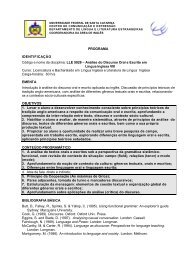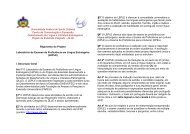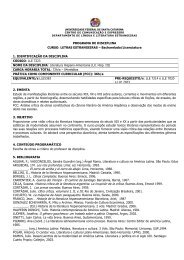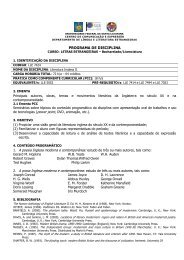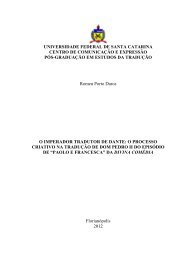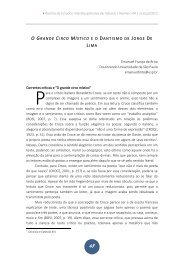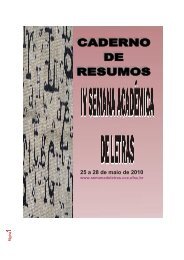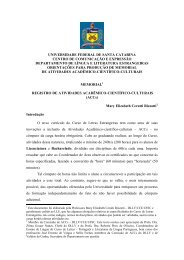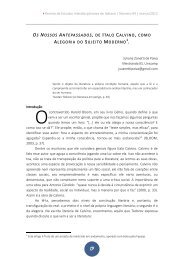Ana Amado é Professora de Análise Filmica e Teoria na ...
Ana Amado é Professora de Análise Filmica e Teoria na ...
Ana Amado é Professora de Análise Filmica e Teoria na ...
- No tags were found...
Create successful ePaper yourself
Turn your PDF publications into a flip-book with our unique Google optimized e-Paper software.
<strong>A<strong>na</strong></strong> <strong>Amado</strong> é <strong>Professora</strong> <strong>de</strong> Análise <strong>Filmica</strong> e <strong>Teoria</strong> <strong>na</strong> Universidad <strong>de</strong> Buenos Aires efoi professora visitante em Princeton e Duke. Autora <strong>de</strong> La Imagen Justa. CineArgentino e Politica (Buenos Aires, Colihue, 2009). Co-autora <strong>de</strong> Espacios <strong>de</strong> Igualdad(Buenos Aires, Fempress), assi<strong>na</strong>, com Nora Dominguez, Lazos <strong>de</strong> Família: Herencias,Cuerpos, Ficciones (Buenos Aires, Paidós, 2004).Em um seminário em Harvard University, <strong>A<strong>na</strong></strong> <strong>Amado</strong> apresentou o paper “Memória,I<strong>de</strong>ntida<strong>de</strong> e Filme. Misturando passado e presente”.Memory, I<strong>de</strong>ntity and FilmMemory, I<strong>de</strong>ntity and FilmBlending Past and PresentBy <strong>A<strong>na</strong></strong> <strong>Amado</strong>The children of the victims of dictatorial terror in the 1970s in Argenti<strong>na</strong> have used avariety of language and poetics to <strong>de</strong>mand justice for their parents’ executioners. At thesame time, they use these diverse expressions as a form of memorial tribute. Filmpossesses the <strong>na</strong>rrative potential to translate the “mournful memories” of history and toachieve “magnificent mourning,” in the optimistic vision of French philosopher JacquesDerrida. Several recent Argentine films took their vital energy from this process, aschildren of the victims <strong>de</strong>dicated themselves to the task of reviewing the past.Since the mid-90s, these creative men and women have been distilling their testimoniesthrough heterogenous <strong>na</strong>rratives based on a mix of references, a variety of voices, a<strong>na</strong>ccumulation of knowledge. Audiovisual material is perhaps the most frequently usedsupporting technique, with new combi<strong>na</strong>tions and unexpected constructions of ways ofcreating private biography through stories with strong historic and <strong>na</strong>rrativeimplications. And this <strong>de</strong>cision to use film (and theatre) as a form of processing one’sown past is what distinguishes this generations of young adults—generally between 25and 35 years old—sons and daughters of the victims or the survivors of the repressionof the 70s. These young men and women are filmmakers, vi<strong>de</strong>o producers and artistswho follow the inter<strong>na</strong>tio<strong>na</strong>l growing trend of the last <strong>de</strong>ca<strong>de</strong> to make documentariesthat explore issues of memory and i<strong>de</strong>ntity.In the group of documentaries <strong>de</strong>dicated to the consequences of the dictatorship, filmsma<strong>de</strong> by the children of the victims and survivors have a very particular role, focusingon history to find a voice and a generatio<strong>na</strong>l space in the context of the present <strong>de</strong>batesabout the 60s and 70s in Argenti<strong>na</strong>. Disregarding the contemporary public discourse,the younger generation has chosen the discourse of the emotions instead of the stri<strong>de</strong>ntpolitical pronouncements that characterized their parents’ generation, as evi<strong>de</strong>nt in thedocumentary films ma<strong>de</strong> in the 60s and in the first half of the 70s in Argenti<strong>na</strong>. That<strong>de</strong>ca<strong>de</strong> witnessed a surge in collective and social forces; neither actions nor i<strong>de</strong>as couldbe linked to individual agents. Representations fostered epic tales—those concerning aheroic guerrilla were the mainstay, with Che Guevara as icon of the generalizedrevolutio<strong>na</strong>ry discourse about armed struggle, while later, “post-history” documentaryfilms bring the individual to illustrate a tragic story-- “post-history” in the sense that it istold from the perspective of the present in which everything seems to have been already
told. Today, the revolutio<strong>na</strong>ry actions of the parents are reconstructed through a<strong>na</strong>esthetic act on the part of their children, who portray them as heroic subjects seenthrough their own <strong>na</strong>rration. Nevertheless, they are resistant to the type of relativelyidyllic representation that characterized documentaries from the earlier generation.In the late 90s and the first years of this century, a series of testimonial documentariesregister a critical or self-critical stance by former political militants and guerrillas, whorevisit their actions in the 70s with the more structured language of politics as aninstitution. A similar ten<strong>de</strong>ncy can be found in testimonial literature. In contrast, thevoices in the documentaries by the children recreate the childhood memories filled withthe violence of kid<strong>na</strong>ppings, absences, <strong>de</strong>ath and images in which the daily perceptionof threats seems to be associated precisely with the language of politics.Each film offers direct or indirect ways of revisiting the actions and political discourseof the previous generation. The filmmakers can elect to remain at the margin of thepolitical arguments that led their parents to sacrifice their lives in or<strong>de</strong>r to concentrateon the failed circuits of their own woun<strong>de</strong>d memories with the help of a familyintegrated by their generatio<strong>na</strong>l and vocatio<strong>na</strong>l peers. The polemical film Los rubios(2003) by Alberti<strong>na</strong> Carri is one example of this type of film. Other films such as M,by Nicolás Privi<strong>de</strong>ra (2007) or Encontrando a Víctor by Natalia Bruchstein (2005),among others, voice quite merciless criticism. Distancing themselves from inheriteddiscourses, each film tries to invent a way of supporting its arguments about what isreaso<strong>na</strong>ble or irratio<strong>na</strong>l, what is sensible or resolutely subversive in the review of thehistory of the period of the dictatorships. And in this review and invention of pastscenes that are imagined in various forms, the children frame the i<strong>de</strong>a of generations asa <strong>na</strong>rrative and temporal construct (as well as a biological one) of genealogy, as a formof resistance to their legacies and, fi<strong>na</strong>lly, as a formal operation of timelessness.The various films are about the absent father or mother, although in the process ofremembering, the direct or <strong>de</strong>flected complaint about the parent’s priorities inevitablyappears. The question becomes why the parent followed the path of <strong>de</strong>sire—that of therevolutio<strong>na</strong>ry cause, even though <strong>de</strong>ath was one of the possible consequences—insteadof guaranteeing his or her presence to the children. The viewer thus catches a glimpse ofan ambivalent image hovering between an epic profile of parents who are protagonistsin a collective historical en<strong>de</strong>avor and at the same time <strong>de</strong>serters in the sphere of privateemotions.At the same time, the very existence of the orphans (or bereaved familiars)is preciselythe proof that we could call unique, that is, symptomatic, of the traumatic way in whichpolitics intertwines with the language of intimacy and of experience. Au unquestio<strong>na</strong>bleexample is Rodolfo Walsh’s "Carta a mis amigos," a mix of accusation and perso<strong>na</strong>ltestimony in which Walsh <strong>de</strong>scribes how and why his daughter Victoria, whom he calls“Vicky,” was assassi<strong>na</strong>ted by the Army in 1977, as he illumi<strong>na</strong>tes the "official"version of the events--a sketchy soldier’s report--from the perspective of the intimacy ofthe father-daughter relationship. "I have witnessed the scene with her eyes,” writesWalsh soon after his daughter’s <strong>de</strong>ath, exchanging time and place with Vicky, withinthe logic of political discourse brought to maximum tension through the intimacy of<strong>de</strong>ath.María Inés Roqué’s Papá Iván and Alberti<strong>na</strong> Carri’s Los rubios are two filmsconstructed around the quarrel with a father’s ghost. Their formal operations ofdisassociation and fragmentation give the films a certain aesthetic mo<strong>de</strong>rnity, although,
paradoxically, they reject the all-encompassing figures of political mo<strong>de</strong>rnity in whichtheir parents participated in the 60s and 70s through their belief in revolution.These representations can be interpreted as signs of simultaneous autonomy and<strong>de</strong>pen<strong>de</strong>ncy regarding the filmmakers’ roots and legacies, which end in an ambiguousstance towards the political choices of their parents and their participation in this violenthistory in which the children, ultimately, became victims. The autonomy has its formalexpression in the use of the first person, in the <strong>na</strong>rrative “I” emphasized through sightand sound, the body and voice anchored in the presence of the author/<strong>na</strong>rrator/protagonist. This autonomy is also expressed through the use of graphics in the form ofsubtitles, whether used to i<strong>de</strong>ntify the convened witness—my mother, my father’scomra<strong>de</strong>, etc.—or to un<strong>de</strong>rscore the meaning of the spoken word. In Los rubios, there isa dual presence, that of Carri as <strong>na</strong>rrator and that of the actress who plays her; in M , themost recent film in this genre, director Nicolás Privi<strong>de</strong>ra plays the role of theinvestigator who becomes increasingly enraged because of the lack of answers in hisquest to find out the truth behind the disappearance of his mother. Narrative <strong>de</strong>cisionsseem to distort the axiom of French literary theorist Roland Barthes about the ten<strong>de</strong>ncyto gag the “I,” or the option of silence to <strong>na</strong>rrate history (historic <strong>na</strong>rrative is in the thirdperson; as Barthes pointed out, “No one is there to make the statement”).On the other hand, <strong>de</strong>pen<strong>de</strong>ncy is revealed in the attachment to origins, in theresurrection of an absent subject that in some cases is portrayed or emerges fitfully; anextreme example of this elision is found in Los rubios in which throughout the entiremovie no image replaces the emptiness of absence. Or the subject is evoked (invoked,<strong>na</strong>rrated, explained) by a series of witnesses that replace the absent (<strong>de</strong>ad) person who isu<strong>na</strong>ble to testify. Precisely on this point, that of the <strong>de</strong>ad witness, the stories of theorphans carry out one of the historian’s paradoxical tasks, which French philosopherMichel <strong>de</strong> Certeau <strong>de</strong>scribes as “the staging of a population of <strong>de</strong>ad people” (1993:62).Through images, texts or testimonies, literally and metaphorically, characters, i<strong>de</strong>as,places, events, situations and values are resuscitated within a historic gallery <strong>de</strong>signedby the <strong>na</strong>rrators and populated by a multiplicity of <strong>na</strong>med portraits: the ghosts of the70s.The language of theatre has operated in a similar fashion. On the local stage, the firstwas Teatro por la I<strong>de</strong>ntidad (I<strong>de</strong>ntity Theatre) which in the past <strong>de</strong>ca<strong>de</strong> has presented acycle of plays <strong>de</strong>stined to support from the realm of creativity the strategy of theGrandmothers of the Plaza <strong>de</strong> Mayo to find and i<strong>de</strong>ntify the young people who werewhisked off as babies from concentration camps by the 1976 dictatorship.A noteworthy play now being performed is Mi vida <strong>de</strong>spués (My Life Afterwards),which brings together characters from the new generation to express theirautobiographical and testimonial “I.” From this starting point, the play forms part of theuniversal ten<strong>de</strong>ncy to transform the discourse of experience into artistic work. Perso<strong>na</strong>lhistory is converted into the direct revelation of collective history. Instead ofrepresenting characters imagined by an author, the characters play themselves and telltheir own stories and those of their parents. Presented as the last link in the Biodramascycle conceived by theatre producer Vivi Tellas within the government-sponsored spaceof the San Martín Theatre in Buenos Aires, this work responds to the i<strong>de</strong>a of a cycleprecisely to make room for stories from real life.Director Lola Arias, born in 1976, is the same generation as her actors-characters. She<strong>de</strong>scribes her staging and intentions: "Six actors born in the <strong>de</strong>ca<strong>de</strong> of the 70s and the
eginning of the 80s reconstruct the youth of their parents through photos, letters, tapes,used clothing, stories and erased memories. Who were my parents when I was born?What was Argenti<strong>na</strong> like before I learned to talk? What versions exist about whathappened when I didn’t yet exist or was so little that I don’t remember? Each actor doesa remake of scenes from the past to un<strong>de</strong>rstand the future. As doubles for the risk oftheir parents, the children wear their clothing and try to present the family history....”On the bor<strong>de</strong>r between reality and fiction, in the encounter between two generations, the“literal” interpretation of scenes from the past perhaps points to a way to transform thefuture. But this “literalness” maintains a distance from verisimilitu<strong>de</strong> through a way oftalking without emphasis, lacking all emotio<strong>na</strong>l overtones, in which the words appear toflow with less fluidity than manipulating images (they use vi<strong>de</strong>o on direct takes, homemovies, photography) , playing instruments (they play the electric guitar, hum melodies,beat drums) or dancing or unbridled corporal play.As is the case of recent Argentine film by the children of the victims, Mi vida <strong>de</strong>spuéscon<strong>de</strong>nses the questions that come up in one work after another, in diverse forms ofexpression, about that time, about doubts and allegiances, about the abyss between thegenerations, about those perso<strong>na</strong>l histories that collectively make up history.This new type of Argentine film and theatre restores the collective dimension out of thefragments of individual, loving discourse that fi<strong>na</strong>lly takes its place as source anddocument for that dramatic span of history.<strong>A<strong>na</strong></strong> <strong>Amado</strong> is an Argentine essayist and film critic. She teaches Film <strong>A<strong>na</strong></strong>lysis andTheory at the Facultad <strong>de</strong> Filosofía y Letras of the Universidad <strong>de</strong> Buenos Aires.Formerly a visiting professor at Princeton and Duke Universities, she is author of thebook La imagen justa. Cine argentino y política (Ed. Colihue) , co-author of the Lazos<strong>de</strong> Familia. Herencias, cuerpos, ficciones (Editorial Paidos)and Espacios <strong>de</strong> Igualdad(Ed. Fempress) , as well as the author of numerous texts in books and magazines inArgenti<strong>na</strong> and abroad.______________________________________________________________________Em “A noção <strong>de</strong> representação da crise no nuevo cine argentino (1999-2004)”, Breno<strong>de</strong> Souza Juz, da UNICAMP, relembra que em artigo recente, apresentado <strong>na</strong> mostra <strong>de</strong>cinema argentino realizada pelo CINUSP, em agosto <strong>de</strong> 2002, <strong>A<strong>na</strong></strong> <strong>Amado</strong>, <strong>de</strong>senvolvea idéia <strong>de</strong> que os filmes do nuevo cine argentino apresentam-se esteticamente como“fábulas do mal-estar”. Apesar <strong>de</strong> mencio<strong>na</strong>r vários filmes que fazem parte da mostra, ocentro do argumento da autora está <strong>na</strong> análise do filme <strong>de</strong> Martel. Apesar <strong>de</strong> aparecer <strong>de</strong>modo sutil, a idéia do cinema argentino contemporâneo como produto da crise sócioeconômicavivida pelo país permeia o artigo, como se po<strong>de</strong> perceber no seguinte trecho:“Cinemas da ficção subjetiva, absolvida da obrigação documentária sobre omundo, mas com uma presença ao mesmo tempo avassaladora do documentárioem sua variante testemunhal, que ensaia códigos diretos para a representação dahistória, a memória e a realida<strong>de</strong> social. (...) a geração <strong>na</strong>scente <strong>de</strong> cineastas estáimpulsio<strong>na</strong>da a inventar novos dispositivos para seus relatos, capazes <strong>de</strong> captar<strong>na</strong>da ou quase <strong>na</strong>da. Consequência da crise que absorve tudo: corpos, figuras,
imagens com uma velocida<strong>de</strong> centrífuga que <strong>de</strong>ixa a realida<strong>de</strong> aturdida,inconseqüente”.Em outro texto, datado <strong>de</strong> 2004, <strong>A<strong>na</strong></strong> <strong>Amado</strong> a<strong>na</strong>lisa novamente O Pântano.Todavia, aautora apresenta uma perspectiva distinta e consi<strong>de</strong>ra o pessimismo e a idéia <strong>de</strong>anulação do futuro como temas recorrentes não só no cinema argentino contemporâneo,mas também no cinema mundial e <strong>na</strong> tradição cinematográfica mo<strong>de</strong>r<strong>na</strong>. Esses temassão vistos <strong>na</strong> reflexão que o cinema mo<strong>de</strong>rno estabelece <strong>de</strong> questões da mo<strong>de</strong>rnida<strong>de</strong>tardia, ao invés <strong>de</strong> conceber tais questões como <strong>de</strong>rivadas <strong>de</strong> uma pontual situação dahistória argenti<strong>na</strong>.



